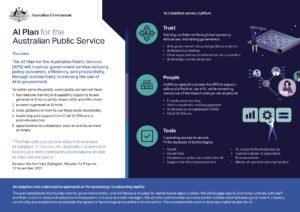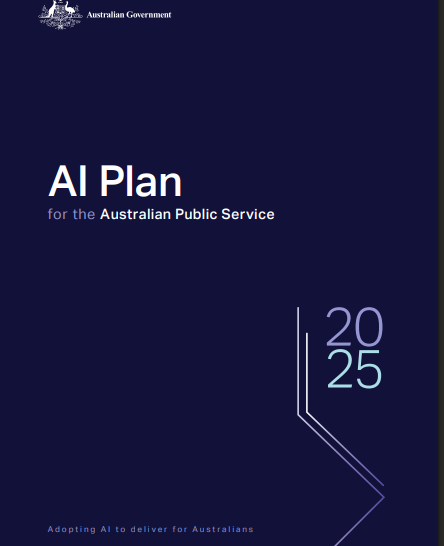With the release of the AI Plan for the Australian Public Service (APS) 2025, the Albanese government has taken a decisive step toward embedding artificial intelligence across the machinery of public administration not as a technological experiment, but as a structural reform.
At its core, the APS AI Plan reimagines how government should function in the algorithmic age: faster, more transparent, and fundamentally people-first. It envisions a future where every public servant from policy officers to service delivery staff has access to secure generative AI tools, guided by rigorous ethical standards and continuous oversight.
Unlike many private-sector AI strategies that chase efficiency alone, this Plan is built around public trust. It acknowledges that innovation in government cannot come at the cost of accountability and that the legitimacy of AI depends on its alignment with the values of democracy, equity, and transparency.
In essence, the APS AI Plan is not just a digital transformation roadmap; it’s a governance statement , one that places ethics at the heart of automation.
The Vision: AI for People, Not Policy Papers
The Plan’s core ambition is clear, to “substantially increase the use of AI in government” in order to improve service delivery, policy outcomes, efficiency, and productivity. Yet, it does so through a deliberate moral framing: AI adoption must benefit people and protect them from harm.
As articulated in the Statement of Intent on AI in the Australian Public Service, AI should be used to make lives better, improve government operations, and ensure benefits are shared equitably. The document sets out the government’s threefold AI ambition — to capture the opportunities of AI, spread the benefits widely, and keep Australians safe.
This “people-first” lens distinguishes the Australian model from more aggressive AI modernization programs elsewhere. It underscores a governance philosophy rooted in social license building citizen trust through transparency, not technological inevitability.

Building on Strong Foundations
Before introducing new mechanisms, the plan acknowledges existing governance and legal pillars already anchoring responsible technology use in Australia. These include:
- The APS Code of Conduct and Values, ensuring integrity and accountability in all service delivery.
- The Privacy Act 1988, governing data protection across agencies.
- The Protective Security Policy Framework (PSPF) and Information Security Manual (ISM), prescribing stringent data and systems safeguards.
- Oversight institutions like the Commonwealth Ombudsman and Australian Human Rights Commission, providing external accountability.
On this foundation, the AI Plan introduces new, AI-specific instruments such as the Policy for the Responsible Use of AI in Government, the AI Impact Assessment Tool, AI Transparency Statements, and a forthcoming AI Review Committee to assess high-risk applications.
Three Pillars of the APS AI Plan: Trust, People, and Tools
The APS AI Plan 2025 is structured around three interdependent pillars — Trust, People, and Tools , forming a holistic governance framework.
- Trust: Transparency, Ethics, and Oversight
At the heart of the plan lies the principle that public trust is non-negotiable. The Trust pillar introduces several initiatives to ensure that AI use in government is ethical, accountable, and transparent:
- AI in Government Policy Updates – Strengthening accountability and mandating risk assessments for high-impact AI applications.
- AI Review Committee – A new oversight body bringing together experts from across the APS, privacy regulators, and ombudsman offices to review sensitive or high-risk AI use cases.
- Clear Expectations for External Service Providers – Requiring contractors to disclose AI use in government projects and remain accountable for all AI-assisted work.
- AI Strategic Communications – A coordinated approach to communicate AI use, risks, and safeguards across the APS to foster internal and public confidence.
Together, these mechanisms embed ethical guardrails and operational transparency — ensuring that every algorithmic decision is traceable and justifiable.
- People: Building a Responsible AI Workforce
The People pillar is about cultural transformation — preparing a 150,000-strong APS workforce to adapt to an AI-enabled environment while preserving the human ethos of public service. It introduces:
- Foundational Learning – Mandatory AI literacy and safety training for all public servants, including senior leaders, to build digital fluency and ethical awareness.
- Consultation and Engagement – Requiring genuine dialogue with staff and unions before AI-driven workplace changes, safeguarding employee trust.
- AI Delivery and Enablement (AIDE) – A new multidisciplinary team to accelerate safe AI adoption across agencies, identify adoption barriers, and share best practices.
- Chief AI Officers (CAIOs) – Senior executives in every department tasked with driving adoption, ensuring compliance, and fostering collaboration across government.
By mandating both top-down leadership and bottom-up participation, the plan aims to make AI adoption a shared journey rather than a bureaucratic imposition.
- Tools: Infrastructure for Secure AI Innovation
No AI strategy can succeed without the right tools — and in this, the APS Plan takes a pragmatic and technical turn. The Tools pillar focuses on infrastructure, data sovereignty, and equitable access:
- GovAI – A central, secure AI hosting platform offering agencies onshore access to vetted generative AI models (including a government-hosted GPT instance), reducing dependence on private vendors.
- GovAI Chat – A government-exclusive generative AI assistant, enabling every APS officer to use AI safely within secure parameters.
- Public and Enterprise AI Guidance – Policies for using tools like ChatGPT or Claude for “OFFICIAL-level” data, balancing innovation with security.
- AI Procurement Guidelines – Streamlined frameworks and new contractual clauses ensuring AI vendors adhere to government ethics and privacy standards.
- Intellectual Property Reuse Platform – A system allowing agencies to share AI-driven solutions and reduce redundancy.
- Central Register of AI Assessments – A repository of security and impact evaluations to speed up safe procurement.
- Whole-of-Government Cloud Policy – Supporting scalable, compliant, and data-sovereign AI infrastructure across agencies.
This technical scaffolding ensures AI use is not just ambitious but operationally safe and cost-efficient.
A Collaborative and Adaptive Governance Model
The APS AI Plan explicitly recognises that AI governance cannot be static. With technologies evolving faster than regulatory frameworks, the Plan takes an adaptive and iterative approach one that welcomes feedback from employees, unions, and external stakeholders including academia and industry.
Cross-sector collaboration will be central to maintaining relevance and inclusivity. Initiatives like GovHack, AI CoLab, and partnerships with the National AI Centre and research institutions will foster a broader ecosystem of innovation and accountability.
Crucially, this flexibility mirrors an emerging trend in global AI governance , a shift from rigid compliance regimes to “learning systems” that evolve alongside technology. The APS Plan reflects this philosophy by embedding monitoring, feedback, and policy iteration as structural features, not afterthoughts.
Assessment: A Model for Public-Sector AI Governance
Viewed through a governance lens, the APS AI Plan 2025 represents a significant maturation of Australia’s digital policy architecture. It connects ethical aspirations with administrative execution , from training and procurement to oversight and risk management.
Yet, its success will depend on three delicate balances:
- Innovation vs. Caution: The Plan aims to accelerate adoption but must avoid bureaucratic overregulation that stifles innovation.
- Centralization vs. Agency Autonomy: While frameworks like GovAI promise consistency, they risk homogenizing agency-specific innovation if too tightly controlled.
- Efficiency vs. Equity: Productivity gains must not come at the cost of workforce displacement or algorithmic bias.
From a governance perspective, the Plan’s layered structure , combining ethical principles, procedural accountability, and technical standards , offers a robust model that could inspire other democracies grappling with the same dilemmas.
Conclusion: A Blueprint for Human-Centred AI Governance
The APS AI Plan 2025 marks a defining moment in Australia’s digital transformation journey , one that sees AI not as an end in itself, but as a means to renew public service around trust, equity, and competence.
For global observers, the Plan embodies what effective AI governance looks like in practice: iterative, transparent, inclusive, and resolutely people-first.
To conclude, governing AI is not about controlling machines , it is about designing systems that preserve human agency in the age of automation. The APS AI Plan, in that sense, may well be Australia’s most human policy yet.

